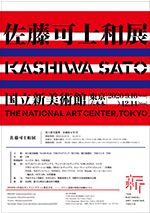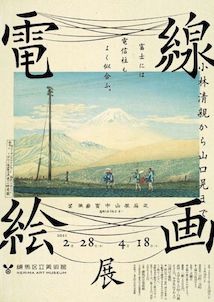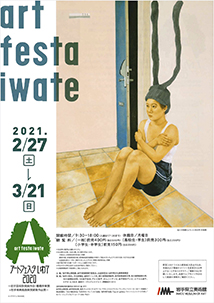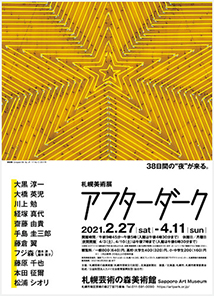 |
Picks is a monthly sampling of Japan's art scene, offering commentary by a variety of reviewers about exhibitions at museums and galleries in recent weeks, with an emphasis on contemporary art by young artists.
Note: Most of Japan's museums and galleries have reopened, but conditions and anti-coronavirus precautions vary. If you are planning a visit, please check the venue's website beforehand. |
 |
 |
|
|
 |
 |
 |
 |
| Kashiwa Sato |
| 3 February - 10 May 2021 |
The National Art Center, Tokyo
(Tokyo) |
 |
| An exhaustive look at the career of designer and art director Sato (b. 1965), this show covers everything from collages he made in elementary school to life-size installations of his outdoor ads and giant logos. Sato's original style of "iconic branding" is simple and eye-catching. Though logo-centric, its ultimate purpose is to enhance the overall value of the client's brand. |
|
|
 |
 |
 |
 |
 |
| Midori Ikeda Exhibition |
| 19 December 2020 - 21 March 2021 |
Hokkaido Obihiro Museum of Art
(Hokkaido) |
 |
| Ikeda (b. 1943) started out as a painter, but in recent years has been producing more conceptual installations of 3D objects. Here she presents a monumental stretch of 1-meter-long clear acrylic tubes, each filled with a curling roll of colored plastic tape on which she has stamped the dates, in unbroken sequence, of every day of her life. The colors, rainbow-like in their variation, are keyed to the different places she has lived. |
|
|

|
 |
 |
 |
 |
 |
 |
| The Olympics and Shuji Terayama |
| 3 November 2020 - 31 March 2021 |
Shuji Terayama Museum
(Aomori) |
 |
| Dramatist and all-around avant-garde enfant terrible Terayama (1935-83) reveled in contradictions, like those between the individual and the state, sports and artistic expression, logic and the flesh. His novel Ah, the Wasteland, depicting the lives of social misfits in the gritty entertainment quarter of Shinjuku, Tokyo, began serialization in the monthly Contemporary Eye in 1964, the year of the first Tokyo Olympics. This show examines Terayama's relationship to the Olympics through his 1964 impressions as well as the participation of his theater troupe in an arts festival at the 1972 Munich games. |
|
|
 |
 |
 |
 |
 |
| Power Line Paintings: From Kiyochika Kobayashi to Akira Yamaguchi |
| 28 February - 18 April 2021 |
Nerima Art Museum
(Tokyo) |
 |
|
Wires on poles -- telephone, telegraph, electric -- were admired as a symbol of Japan's rapid modernization in the Meiji years. Ukiyo-e artist Kobayashi (1847-1915) featured them prominently in his prints; painter Ryusei Kishida employed them as signs of Tokyo's growth; Gentaro Koito criss-crossed his canvases with wires emblematic of the modern city; and Kanemon Asai earned the nickname "Mr. Power-Line Landscape" for his devotion to the motif. Contemporary artist Yamaguchi carries on the tradition today.
|
|
|
|
|
|
|
|

|
 |
 |
|
 |
 |
 |
 |
| The Words for Architecture |
| 12 December 2020 - 30 May 2021 |
WHAT
(Tokyo) |
 |
|
Inspired, we are told, by the poet-architect Michizo Tachihara, this exhibition links architecture and literature in an exploration of houses created by architects who squarely addressed the concept of living space in their works. Poet Shuntaro Tanikawa offers a new poem about his home, Tanikawa House, designed by Kazuo Shinohara. Residences by Junzo Yoshimura, Yoshifumi Nakamura, and Fuminori Nosaku receive similar treatment from various poets and playwrights.
|
|

|
 |
 |
 |
 |
 |
 |
 |
| Art Festa Iwate 2020 |
| 27 February - 21 March 2021 |
Iwate Museum of Art
(Iwate)
|
 |
| In its 18th iteration this year, Art Festa Iwate introduces 100 works by area artists, both professional and amateur, who were prizewinners in last year's Iwate Arts Festival competition, as well as those recommended by jurors in 10 different genres -- Nihonga, prints, sculpture, photography and so on. Added for good measure are winners of the 2018 Iwate Art Encouragement Prize. Featured artists include Natsumi Sasaki, Eiji Hirano, Kazuo Suzuki, and Kaitaro Sasaki. |
|
|
 |
 |
 |
 |
 |
| After Dark |
| 27 February - 11 April 2021 |
Sapporo Art Park
(Hokkaido) |
 |
| This show brings together 11 artists and art units of diverse genres with roots in Sapporo to explore the forms of artistic expression that emerge in the hours after sunset. In the curator's words: "When the sun sinks below the horizon and darkness creeps over the earth, night visits us all, without exception. Much of human civilization and culture is the product of our desire to surmount the loneliness and fear that assails us during those dark hours. Waking and sleeping, life and death, stars shining in the night sky and city streets illuminated by neon -- all nocturnal phenomena serve as inspirations for artistic creation." |
|
|
|
|
|
|
|
|
|
 |
|